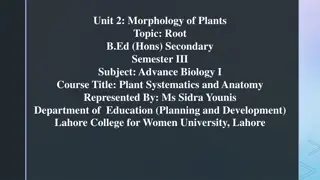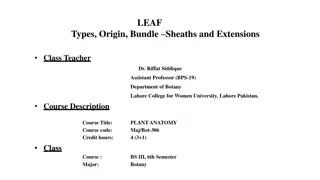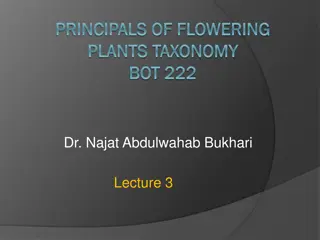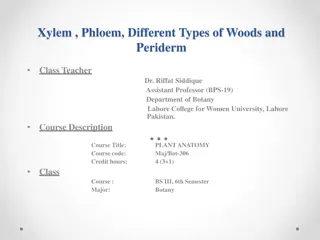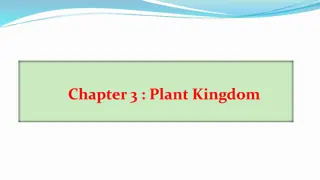Understanding Plant Anatomy and Characteristics
Explore the diverse aspects of plant life cycles, habitats, vegetative organs, stems, aerial stem modifications, leaves, phyllotaxy patterns, and leaf durations. Gain insights into the classification of roots, different types of plant habitats, and the arrangement of leaves on stems. Discover the various adaptations of plants to different environmental conditions.
Download Presentation

Please find below an Image/Link to download the presentation.
The content on the website is provided AS IS for your information and personal use only. It may not be sold, licensed, or shared on other websites without obtaining consent from the author. Download presentation by click this link. If you encounter any issues during the download, it is possible that the publisher has removed the file from their server.
E N D
Presentation Transcript
Plants can be divided to many aspects according to their life cycle :- 1-Annual. 2- Biennial. 3- Perennial
Plant habitat It refers to the general environment where plant is growing, these include the following: 1/Terrestial 2/ Aquatic
Vegetative organs Roots: Classification of roots according to origin:- 1/ Primary roots 2/ Adventitious roots
Stems 1-Aerial stem 2-Subterranean stems (underground)
Modification of Aerial stems 1- Phylloclades or cladodes 2- Spiny 3-Tendriller
Leaves They are the primary photosynthetic organs of plants, functioning also as the main site of transpiration. Leaves are usually arising from nodes. A leaf can be gametophytic as in the leafy liverworts and mosses or sporophytic, in the vascular plants. leaf parts: 1* Blade or lamina 2* Petiole 3* Leaf sheath 4* Pseudo petiole 5* Stipules
Phyllotaxy It s the pattern of arrangement of leaves on the stem, there are three main types of phyllotaxy:- 1* Alternate 2* Opposite 3* Whorled
Leaf duration : Leaves may stay and function for few days to many year, largely determined by the adaptation to climatic conditions: A/ Ever green B/ Deciduous C/Caducuous



